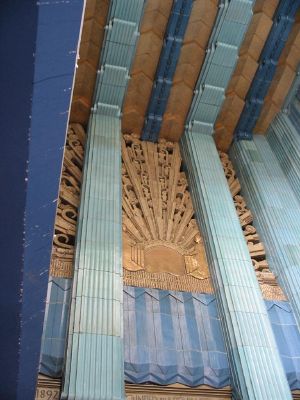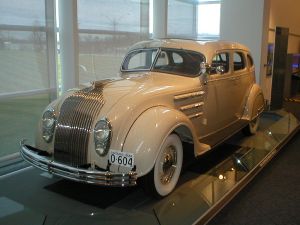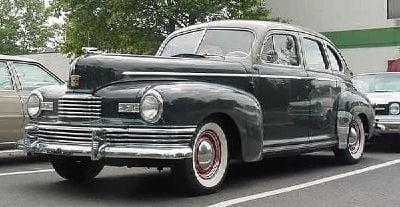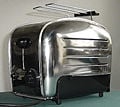Art Deco
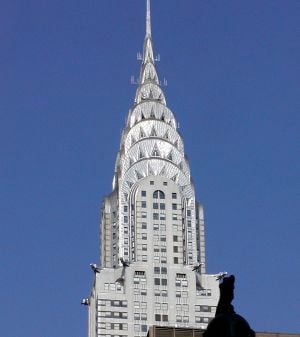
Art Deco was a popular international design movement from 1925 until 1939, affecting the decorative arts such as architecture, interior design, and industrial design, as well as the visual arts including fashion, painting, the graphic arts, and film. This movement was an amalgam of many different styles and movements of the early twentieth century, including Neoclassical, Constructivism, Cubism, Modernism, Bauhaus, Art Nouveau, and Futurism.
Art Deco experienced a decline in popularity during the late 1930s and early 1940s, and soon fell out of public favor. The time frame was roughly from the World's Fair in Paris in 1925 to the World's Fair in New York in 1939. Afterward, Art Deco experienced a resurgence with the advent of graphic design in the 1980s. Surviving examples may still be seen in many different locations worldwide, in countries as diverse as the United Kingdom, Cuba, the Phillipines, and Brazil. Many classic examples still exist in the form of architecture in many major cities. The Chrysler building, designed by William Van Alen, is a classic example of this, as it is one of the most notable examples of Art Deco architecture today. Other prominent examples include the Empire State Building and the New Yorker Hotel in New York City.
While most of the modern art movements were grounded in ideology, Art Deco was a celebration of modern life and style, seeking elegance over philosophical content.
History
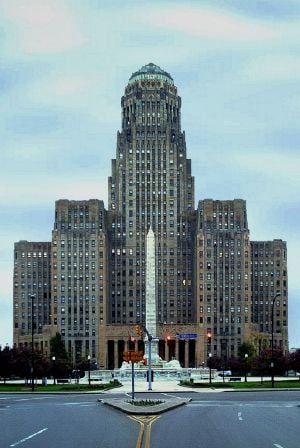
After the Universal Exposition of 1900, various French artists formed an informal collective known as, La Société des artistes décorateurs (the society of the decorator artists). Founders included Hector Guimard, Eugène Grasset, Raoul Lachenal, Paul Follot, Maurice Dufrene, and Emile Decour. These artists heavily influenced the principles of Art Deco as a whole. This society's purpose was to demonstrate French decorative art's leading position and evolution internationally. They organized the 1925 Exposition Internationale des Arts Décoratifs et Industriels Modernes (International Exposition of Modern Industrial and Decorative Art) in Paris, which would feature French art and business interests.[1] The terms Style Moderne and Art Deco both derive from the exposition's title, though Art Deco was not widely used until popularized by art historian Bevis Hillier's 1968 book Art Deco of the 20s and 30s.[2]
In the summer of 1969, Hillier conceived organizing an exhibition called Art Deco at the Minneapolis Institute of Arts, which took place from July to September 1971. After this event, interest in Art Deco peaked with the publication of his 1971 book The World of Art Deco, a record of the exhibition.[3]
Sources
The structure of Art Deco is based on mathematical geometric shapes. It was widely considered to be an eclectic form of elegant and stylish modernism which derived from a variety of sources. Among them were the so-called "primitive" arts of Africa, Ancient Egypt, and Aztec Mexico, as well as machine-age or streamline technology such as modern aviation, electric lighting, the radio, the ocean liner and the skyscraper. It is in Streamline Moderne styles that this technology fully manifests itself and, although it is not antithetical to Art Deco, it is now considered to be a separate architectural style.[4]
Art Deco design influences were expressed in fractionated, crystalline, faceted forms of decorative Cubism and Futurism, in Fauvism's palette.[5] Other popular themes in Art Deco were trapezoidal, zigzagged, geometric, and jumbled shapes, which can be seen in many early pieces. Two great examples of these themes and styles are in Detroit, Michigan: the Fisher Building and the Guardian Building.[6]
Corresponding to these influences, Art Deco is characterized by use of materials such as aluminum, stainless steel, lacquer, inlaid wood, sharkskin (shagreen), and zebraskin. The bold use of stepped forms and sweeping curves (unlike the sinuous, natural curves of the Art Nouveau), chevron patterns, and the sunburst motif are typical of Art Deco. Some of these motifs were ubiquitous‚Äďfor example, sunburst motifs were used in such varied contexts as ladies' shoes, radiator grilles, the auditorium of the Radio City Music Hall, and the spire of the Chrysler Building.
Attributes
Architecture and Interior Design
Art Deco was an opulent style, and its lavishness is attributed to reaction to the forced austerity imposed by World War I. Its rich, festive character fitted it for "modern" contexts, including the Golden Gate Bridge, interiors of cinema theaters (such as the Paramount Theater in Oakland, California) and ocean liners such as the Île de France, the Queen Mary, and Normandie. Art Deco was employed extensively throughout America's train stations in the 1930s, designed to reflect the modernity and efficiency of the train. The first art-deco train station in the United States was the Union Station in Omaha, Nebraska.[7] The unveiling of streamlined trains paralleled the construction of the art deco stations.
1925 World's Fair
The term "Art Deco" comes from the Exposition Internationale des Arts Décoratifs et Industriels Modernes (International Exposition of Modern Industrial and Decorative Arts), the World's fair held in Paris, France from April to October 1925. It was derived by shortening the words "Arts Décoratifs" in the title of the exposition.[8] Artistic creation in the années folles in France is marked by this event, when on this occasion many ideas of the international avant-garde in the fields of architecture and applied arts were brought together. This major event of the 1920s was located between the esplanade of Les Invalides and the entrances of the Grand Palais and Petit Palais. It received 4000 guests at the inauguration on April 28, and thousands of visitors each of the following days.
This exhibition generated the term Art Deco to describe designs in terms of a broad decoratively "modern" style, characterized by a streamlined classicism and facetted, crystalline structures, embellished with decorative references to sleek machinery, and recurrent motifs of stylized fountains,[9] gazelles,[10] lightning flashes, "Aztec" motifs and similar repertory, derived in part from Decorative Cubism.
The central body of exhibits seemed to present the fashionable products of the luxury market, a signal that, after the disasters of World War I, Paris still reigned supreme in the arts of design.
Art Deco left its impact in a variety of different media, including furniture, jewelry, painting and sculpture, even poster art and postage stamps.
Streamline Moderne
A parallel movement called Streamline Moderne, or simply Streamline, followed close behind. Streamline was influenced by the modern aerodynamic designs emerging from advancing technologies in aviation, ballistics, and other fields requiring high velocity. The attractive shapes resulting from scientifically applied aerodynamic principles were enthusiastically adopted within Art Deco, applying streamlining techniques to other useful objects in everyday life, such as the automobile. Although the Chrysler Airflow design of 1933 was commercially unsuccessful, it provided the lead for more conservatively designed pseudo-streamlined vehicles. These "streamlined" forms began to be used even for mundane and static objects such as pencil sharpeners and refrigerators.
Art Deco celebrates the Machine Age through explicit use of man-made materials (particularly glass and stainless steel), symmetry,[11] repetition, modified by Asian influences such as the use of silks and Middle Eastern designs. It was strongly adopted in the United States during the Great Depression for its practicality and simplicity, while still portraying a reminder of better times and the "American Dream."
Art Deco made use of many distinctive styles, but one of the most significant of its features was its dependence upon a range of ornaments and motifs.[12] The style is said to have reflected the tensions in the cultural politics of its day, with eclecticism having been one of its defining features.[12] In the words of F. Scott Fitzgerald, the distinctive style of Art Deco was shaped by "all the nervous energy stored up and expended in the War."[13] Art Deco has been influenced in part by movements such as Cubism, Russian Constructivism and Italian Futurism, which are all evident in Art Deco decorative arts.[1]
Decline and Resurgence
Art Deco slowly lost patronage in the West after reaching mass production, when it began to be derided as gaudy and presenting a false image of luxury. Eventually, the style was cut short by the austerities of World War II. In colonial countries such as India and the Philippines, it became a gateway for Modernism and continued to be used well into the 1960s. Before their destruction during World War II, Manila possessed many art-deco buildings; a legacy of the American colonial past. Theaters and office buildings were lost in the war or later demolished and abandoned for new development.
A resurgence of interest in Art Deco came with graphic design in the 1980s, where its association with film noir and 1930s glamor led to its use in ads for jewelry and fashion.[14]
Memphis Group
Art Deco also helped to inspire the Memphis Group, an influential Italian design and architecture movement of the 1980s. The group was founded by Ettore Sottsass. The group, which eventually counted among its members Martine Bedin, Andrea Branzi, Aldo Cibic, Michele de Lucchi, Nathalie du Pasquier, Michael Graves, Hans Hollein, Arata Isozaki, Shiro Kuromata, Matteo Thun, Javier Mariscal, George Sowden, Marco Zanini, and the journalist Barbara Radice, disbanded in 1988.
Named after the Bob Dylan song Stuck Inside of Mobile with the Memphis Blues Again, the movement was a reaction against the post-Bauhaus "black box" designs of the 1970s and had a sense of humor that was lacking at the time in design. The Memphis Group offered bright, colorful, shocking pieces. The colors they used contrasted the dark blacks and browns of European furniture. In addition to Art Deco, they drew inspiration from Pop Art as well as the 1950s Kitsch and futuristic themes. Their concepts were in stark contrast to so called 'Good Design'.
Legacy
Art Deco owed much to numerous early twentieth century art movements, including Bauhaus and Futurism,[12] while exerting a profound influence on many later artistic movements, such as Memphis and Pop art. Its popularity peaked in Europe during the Roaring Twenties and continued strongly in the United States through the 1930s. Although many design movements have political or philosophical roots or intentions, Art Deco was purely decorative. At the time, this style was seen as elegant, functional, and modern.
Surviving examples
Some of the finest surviving examples of art-deco art and architecture are found in Cuba, especially in Havana. The Bacardi Building is the best known of these. The style is expressed in the architecture of residences, businesses, hotels, and many pieces of decorative art, furniture, and utensils in public buildings, as well as in private homes.[3]
Another country with many examples of rich art-deco architecture is Brazil, specially in Goi√Ęnia and cities like Cip√≥ (Bahia), Ira√≠ (Rio Grande do Sul) and Rio de Janeiro, especially in Copacabana. Also in the Brazilian Northeast‚ÄĒnotably in countryside cities, such as Campina Grande in Paraiba State‚ÄĒthere is a noticeable group of Art Deco buildings, which has been called ‚ÄúSertanejo Art Deco‚ÄĚ because of its peculiar architectural features.[15] The art deco style is widespread in Brazil due to its coincidence with the fast growth and radical economic changes of the country during 1930-1940.
South Beach in Miami Beach, Florida has the largest collection of Art Deco architecture remaining in North America. Much of the Art Deco heritage of Tulsa, Oklahoma remains from that city's oil boom days.[16]
Art Deco in 1930s house design in the UK
Dwelling-house design during the 1930s in the UK was also very much influenced by Art Deco. Straight, white-rendered house frontages rising to flat roofs, sharply geometric door surrounds, Egyptian motifs, tall windows as well as convex curved metal corner windows or even round bull's-eye windows (reminiscent of ocean-liner design), all were characteristic of that period[17] However, during double-glazing transformations in the late twentieth century, many of the original art deco window features were lost and replaced by less distinctive styles.
The 1930s was the period during which most building of homes specifically for sale took place in the UK. Despite loss of some classic art-deco features from remodeling in subsequent decades, the large number of houses remaining from the period ensures that many fine examples of art-deco housing can still be viewed.
Of particular note in the typical '1930s semi' are sunrise-symbol-motif doors, garden gates and garages as well as the infamous 'suntrap' window (featuring a distinct one-sided curve) and the linear form of the famous critall window. There are features such as monochrome wall and floor tiling and bakelite door-knobs in simple geometric designs, sometimes with deco-flourished fingerplates or escutcheons.
Fine examples of luxurious art-deco homes are now vested in organizations such as English Heritage and The National Trust in the UK. Both organizations seek to maintain and restore historic homes and facilitate paid public access. A particularly beautiful example is Eltham Palace[18], built in 1936 by Stephen and Virginia Courtauld, close to the ruins of Henry VIII's boyhood home in London. It features a large circular reception room with a glass roof, beautifully impressive bathroom, bedrooms and dining rooms and all of the original furnishings and features, including a house-wide radio system and an arterial vacuum-cleaning system.
Gallery
Notes
- ‚ÜĎ 1.0 1.1 Alastair Duncan, (ed.), The Encyclopedia of Art Deco: A Visual Guide to the Influential Design Movement (original 1988) (London: Grange Books, 2005, ISBN 1840138238).
- ‚ÜĎ Bevis Hillier, Art Deco of the 20s and 30s (Studio Vista/Dutton picturebacks, 1968, ISBN 978-0289277881).
- ‚ÜĎ 3.0 3.1 Bevis Hillier, The World of Art Deco (New York: E.P. Dutton & Co Inc, 1971, ISBN 9780525482383).
- ‚ÜĎ Alastair Duncan, Art Deco Complete (Harry N. Abrams, 2009, ISBN 978-0810980464).
- ‚ÜĎ Charlotte Jirousek, Art, Design, and Visual Thinking - Art Deco Cornell University, 1995. Retrieved March 5, 2021.
- ‚ÜĎ Rebecca Binno Savage and Greg Kowalski, Art Deco in Detroit (Images of America) (Mount Pleasant, SC: Arcadia Press, 2004, ISBN 0738532282).
- ‚ÜĎ Carla Johnson, Union Pacific and Omaha Union Station (J & L Lee Co., 2000, 978-0934904445).
- ‚ÜĎ Theodore Menten, The Art Deco Style in Household Objects, Architecture, Sculpture, Graphics, Jewelry (Courier Dover, 1972, ISBN 048622824X).
- ‚ÜĎ Ren√© Lalique's crystal tower fountain was a prominent set-piece of the Exposition.
- ‚ÜĎ The Exposition poster, by Robert Bonfils, imitating the look of a woodblock print, featured a modern athletic nymph and a racing gazelle.
- ‚ÜĎ Art Deco Jewelry (1920-1930) Arlecchino Antique Jewelry. Retrieved March 5, 2021.
- ‚ÜĎ 12.0 12.1 12.2 Ghislaine Wood, "Traditional Motifs," in Essential Art Deco (London: Victoria and Albert Museum Publications, 2003), 21.
- ‚ÜĎ F. Scott Fitzgerald, The Jazz Age (New York: New Directions Publishing, 1996, ISBN 0811213331), 3.
- ‚ÜĎ Pamela Gaunt, The Decorative in Twentieth Century Art: A Story of Decline and Resurgence (VDM Verlag Dr. M√ľller, 2010, ISBN 978-3639223484).
- ‚ÜĎ Jos√© Marconi B. de Souza, and Lia Monica, Sertanejo Art Deco: an inspiration for a Brazilian design? 2012. Retrieved March 5, 2021.
- ‚ÜĎ Tulsa Art Deco Tulsa Preservation Commission. Retrieved March 5, 2021.
- ‚ÜĎ Art Deco Buildings: London examples London Footprints. Retrieved March 5, 2021.
- ‚ÜĎ Eltham Palace and Gardens English Heritage. Retrieved March 5, 2021.
ReferencesISBN links support NWE through referral fees
- Applegate, Judith. Art Deco. New York: Finch College Museum Of Art/Cranbrook Academy of Art, 1970. OCLC 140990
- Bayer, Patricia. Art Deco Architecture Design, Decoration and Detail from the Twenties and Thirties. London: Thames & Hudson, 1999. ISBN 0500281491.
- Benton, Charlotte, Tim Benton, and Ghislaine Wood, with Oriana Baddeley, Collaborator. Art Deco: 1910-1939. Boston: Little Brown & Co., 2003. ISBN 9780821228340.
- Breeze, Carla. American Art Deco: Modernistic Architecture and Regionalism. New York: WW Norton & Co., 2003. ISBN 0500281491.
- Duncan, Alastair (ed.). Encyclopedia of Art Deco: A Visual Guide to the Influential Design Movement. (original 1988) London: Grange Books, 2005. ISBN 1840138238.
- Duncan, Alastair. Art Deco Complete. Harry N. Abrams, 2009. ISBN 978-0810980464
- Fischer, Lucy. Designing Women: Cinema, Art Deco and the Female Form. New York: Columbia University Press, 2003.
- Gallagher, Fiona. Christie's Art Deco. Watson Guptill Publications, 2002. ISBN 1862055092.
- Gaunt, Pamela. The Decorative in Twentieth Century Art: A Story of Decline and Resurgence. VDM Verlag Dr. M√ľller, 2010. ISBN 978-3639223484
- Hillier, Bevis. Art Deco of the 20s and 30s. Studio Vista/Dutton, 1968. ISBN 0289277884.
- Hillier, Bevis. The World of Art Deco. New York, E.P. Dutton & Co., Inc., 1971. ISBN 9780525482383.
- Johnson, Carla. Union Pacific and Omaha Union Station. J. & L. Lee Company, 2000. 978-0934904445
- Menten, Theodore. The Art Deco Style in Household Objects, Architecture, Sculpture, Graphics, Jewelry. New York: Courier Dover, 1972. ISBN 048622824X
- Ray, Gordon N. The Art Deco Book In France. The Bibliographical Society of The University of Virginia, Charlottesville, 2005. ISBN 1883631122.
- Savage, Rebecca Binno, and Greg Kowalski. Art Deco in Detroit (Images of America). Arcadia, 2004. ISBN 0738532282.
- Schwartzman, Arnold. Deco LAndmarks: Art Deco Gems of Los Angeles. Chronicle Books, 1995. ISBN 0811846016.
- Unes, Wolney. Identidade Art Deco de Goi√Ęnia. Ateli√™, 2003. ISBN 8574800902.
- Wood, Ghislaine. "Traditional Motifs", Essential Art Deco. London: Bulfinch, 2003. ISBN 0821228331. (Victoria and Albert Museum Publications, 21.) (Co-curator of the exhibition Art Deco 1910-1939)
External links
All links retrieved August 15, 2023.
- Art Deco Montreal
- Art Deco Society, Victoria, Australia
- Art Deco Society of Washington
- Art Deco Society of California
- Napier, New Zealand Art Deco Trust
| Western art movements |
| Renaissance · Mannerism · Baroque · Rococo · Neoclassicism · Romanticism · Realism · Pre-Raphaelite · Academic · Impressionism · Post-Impressionism |
| 20th century |
| Modernism ¬∑ Cubism ¬∑ Expressionism ¬∑ Abstract expressionism ¬∑ Abstract ¬∑ Neue K√ľnstlervereinigung M√ľnchen ¬∑ Der Blaue Reiter ¬∑ Die Br√ľcke ¬∑ Dada ¬∑ Fauvism ¬∑ Art Nouveau ¬∑ Bauhaus ¬∑ De Stijl ¬∑ Art Deco ¬∑ Pop art ¬∑ Futurism ¬∑ Suprematism ¬∑ Surrealism ¬∑ Minimalism ¬∑ Post-Modernism ¬∑ Conceptual art |
| |||||||||||
Credits
New World Encyclopedia writers and editors rewrote and completed the Wikipedia article in accordance with New World Encyclopedia standards. This article abides by terms of the Creative Commons CC-by-sa 3.0 License (CC-by-sa), which may be used and disseminated with proper attribution. Credit is due under the terms of this license that can reference both the New World Encyclopedia contributors and the selfless volunteer contributors of the Wikimedia Foundation. To cite this article click here for a list of acceptable citing formats.The history of earlier contributions by wikipedians is accessible to researchers here:
- Art_Deco  history
- Art_Deco  history
- Memphis_Group  history
- Exposition_Internationale_des_Arts_Décoratifs_et_Industriels_Modernes  history
The history of this article since it was imported to New World Encyclopedia:
Note: Some restrictions may apply to use of individual images which are separately licensed.
